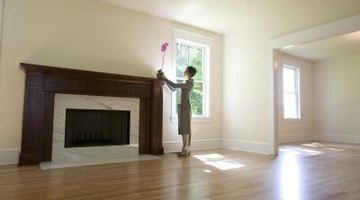The Installation of Masonite Hardboard Floors
Masonite hardboard is made up of leftover wood chips and sawdust. The leftover wood is steam pressed with a natural resin called lignin to make durable sheets of engineered wood. Masonite's strength is due to inter-fiber bonding that occurs during the steam process. As Masonite's strength and resistance to weather grew, production expanded into floor products.
Substrate

When it is used as a substrate, Masonite hardboard flooring extends the life of your final flooring. You can use it under rubber, carpet, cork, PVC, hardwood and tile, preventing uneven joints in the subfloor. It is resistant to cracking and breaking and smooths out your floor so that you have a level base on which to work. Masonite can be used as a subfloor, installed directly over the joists or as a substrate installed on top of the subfloor and under the final flooring.
Preparation
Check your floors for decay. Check to make sure there is adequate air flow beneath the floors. Make sure your subfloor is not damp. Remove any broken or loose pieces of subflooring and hammer down any protruding nails or staples. Your floor does not have to be perfect because Masonite will cover some imperfections. Lay out your Masonite sheets on the floor so that the joints are varied. Do not create long lines of joints, but lay the sheets the way you would lay bricks, in a zig-zag-type pattern. Leave a 0.4 mm gap between sheets for expansion and contraction. Cut Masonite sheets with a table or circular saw. Choose boards that are the same thickness.
Installation
Let the hardboard sit for a day. The hardboard raises your floor height, so you will have to trim your doors. You may have to cut around pipes with a jig saw. Affix the Masonite hardboard floor to your subfloor using staples or ring-grooved buttress nails. If you are using the Masonite over particleboard or plywood, lay an adhesive down under the Masonite before stapling or nailing the hardboard in place. Do not drive the nails or staples into the joists. Always double-check your work. Hammer in any protruding nails or staples and allow the adhesive to dry completely. Sand the floor, especially the joints, with a machine-based flat sander so the hardboard is level and smooth. Remove any dust from the floor and out of the joints.
Environment
Because it is made up of excess or scrap wood left at the lumber yards and in forests, Masonite is an environmentally friendly product. Masonite is made from natural glues, too. Even dust pollution is reduced because the product is steamed together. Masonite should not be stored in damp or hot locations or in direct sunlight.
Writer Bio
Rebekah Smith is a writer and editor from Montana and the owner of several businesses. Smith has consulted and worked with businesses in the fields of commercial greenhouses, ecommerce, technology and home improvement. She holds a Master of Business Administration and is working on a Ph.D. in business.
Photo Credits
- David Sacks/Lifesize/Getty Images
More Articles



